| Stevens Model 200:
Defining Value & Offering Performance | ||||||||||||||||||||||||||||||||||||||||||||||||||||||||||||||||||||||||||||||||||||||||
|---|---|---|---|---|---|---|---|---|---|---|---|---|---|---|---|---|---|---|---|---|---|---|---|---|---|---|---|---|---|---|---|---|---|---|---|---|---|---|---|---|---|---|---|---|---|---|---|---|---|---|---|---|---|---|---|---|---|---|---|---|---|---|---|---|---|---|---|---|---|---|---|---|---|---|---|---|---|---|---|---|---|---|---|---|---|---|---|---|
|
Base models offer "strictly business" shoppers with function over frills and also let manufacturers begin earning customer brand loyalty. While the Stevens Model 200 does both, its performance also makes it one heck of a value.
By Scott E. Mayer -- Shooting Times | ||||||||||||||||||||||||||||||||||||||||||||||||||||||||||||||||||||||||||||||||||||||||
My evaluation of the Stevens Model 200 bolt-action rifle corresponded with my buying a new truck. If you haven't been new truck shopping lately, it's hard to find one that isn't essentially a luxury vehicle that has a bed on the back. Standard equipment on some models these days includes such things as multiple zone automatic climate controls, XM radio, satellite electronics, and heated mirrors. All I wanted was a truck--something strong and well built that a muddy, wet bird dog could get in without me freaking about damaging Corinthian leather. I didn't need a status symbol to take the weekly garbage to the dump or haul deer out of the woods. I had given up in frustration and was ready to consider restoring a classic truck when the Stevens blew in here like a breath of fresh air and renewed my faith in manufacturing sanity. Here was a rifle that was what I was looking for in a truck: a no-frills tool--plain and simple. There's no wood to warp, no delicate finish to scratch. It's a rifle.
It obtains its performance heights in terms of function first and foremost. That it uses the time-tested Savage Model 110 action assured me it was strong, and free-floated, button-rifled Savage barrels have always provided me with accuracy that belies their moderate price tags, so I was confident about its accuracy. I was also floored to see that the Stevens 200 retails for only $316 even though skilled union workers in a New England state known for high taxes and operating costs made it. To get the price tag down without sacrificing quality, Savage (Dept. ST, 118 Mountain Rd., Suffield, CT 06078; 413-568-7001; www.SavageArms.com) did exactly what auto manufacturers do--offer a base product that's essentially the same under the hood as the higher end models and then let the higher end models with the extra bells and whistles carry the margin. In terms of automobiles, then, the Stevens 200 can be thought of as the base, with the Savage-brand being the upgrade thus carrying more options such as left-hand, different finishes, wood stocks, and muzzle porting. A No-Frills Work Gun
It didn't save any money at the manufacturing or retail level, but another thing Savage did with the Stevens line was instead of waiting to retire an on-line and fully functional Savage synthetic stock mold, the company bought a new mold for the Savage line and relegated the "hand-me-down" mold to the Stevens line.
This is an effective use of equipment as it ages, and at Savage it isn't unique to the stocks. While visiting the factory a few years back I saw where barrels go through a multiple reaming process called "broaching." The oldest reamer in the series does the first cut, and when the barrel gets the final "broach," it's done by the newest reamer, resulting in the best possible finish. Just like a base model truck may come standard with a bench seat with the next higher version having captain's chairs, the Stevens comes with the familiar Savage trigger. It's hand set at the factory to a reasonable pull weight and can be further adjusted by a competent gunsmith. The trigger upgrade, if you will, is the AccuTrigger. It has added safety features and is user adjustable down to about 11/2 pounds of pull, but you have to upgrade from the Stevens rifle to a Savage to get it.
While you can often get base model vehicles in a limited variety of colors, the Stevens Model 200 comes only with a gray synthetic stock and blued steel. Variety kicks in with calibers. You won't find base trucks with much in the way of engine choices, but in the Stevens Model 200 you'll find no less than five short-action chamberings from .223 Remington to .308 Winchester. Available long-action chamberings include .25-06, .270 Winchester, and .30-06 Springfield, you can also have 7mm Remington Magnum or .300 Winchester Magnum. I received a long-action sample chambered in .30-06 Springfield to evaluate. It has everything a no-nonsense shopper could want in a basic rifle including sling swivel studs and an action already drilled and tapped for scope mounting. It was a simple matter to select a matching pair of Warne Maxima rings and bases for a perfect fit.
In them, one of the new-style Simmons ProSport 3-9X 40mm riflescopes drops right in without a glitch. For me, it was as though that ensemble was made to go together. I had a rifle with that "classic" American bolt-action look and the redesigned Simmons scope proportioned like a sporter riflescope should be instead of like a couple of beverage cans joined by a section of conduit as was the rage a few years back. Possibly The Best Value In Bolt Actions
Budget-conscious shooters shoot inexpensive ammunition, and entry-level shooters should start with low-recoils loads. For those two reasons, I included Golden Bear ammunition as an economy load and Remington's Managed Recoil as a low-recoil load. I wasn't disappointed with either in the accuracy department. Golden Bear does have quite a muzzle flash, though, which probably indicates some of its economy may come from simply leaving out flash suppressant from the powder formula. Remington's Managed Recoil is nothing short of a powder puff on the recoil end, even in the 6.5-pound Stevens Model 200. I have used .300 Winchester Magnum Managed-Recoil loads for whitetail and found them to also be great within their range limitations on the receiving end. Winchester's Super-X 150-grain Power-Point loading showed that the Stevens can deliver power and accuracy from full-power, name-brand factory ammunition, and I used Hornady's 150-grain InterLock in a moderate handload because the InterLock has always been a benchmark for me in hunting bullet performance. I can find hunting bullets that shoot better or worse for every rifle, but the InterLock has been really consistent for me in terms of accuracy, and its performance on game has never let me down. My benchmark for accuracy in a .30-caliber rifle is naturally Sierra's 168-grain MatchKing, so I included a handload with it even though I doubt many Stevens Model 200 rifles will ever seriously be used with target ammunition. My best group with the MatchKing was 0.68 inch, which is something to write home about with any mass-produced hunting rifle.
Savage says the Stevens Model 200 "is the best value in a bolt-action rifle." Honestly, I don't know the retail prices of all bolt-action rifles, and I sure haven't shot all of them, so I can't say with absolute certainty if that's the case with the Stevens. Even so, I think it's accurate for me to say that if the Stevens isn't the best value in a bolt-action rifle, it's darn close. NOTE: All load data should be used with caution. Always start with reduced loads first and make sure they are safe in each of your guns before proceeding to the high test loads listed. Since Shooting Times has no control over your choice of components, guns, or actual loadings, neither Shooting Times nor the various firearms and components manufacturers assume any responsibility for the use of this data. | ||||||||||||||||||||||||||||||||||||||||||||||||||||||||||||||||||||||||||||||||||||||||

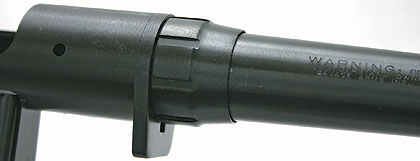 A barrel nut permits quick and easy headspacing during assembly at the factory. The recoil lug is sandwiched between it and the receiver.
A barrel nut permits quick and easy headspacing during assembly at the factory. The recoil lug is sandwiched between it and the receiver.
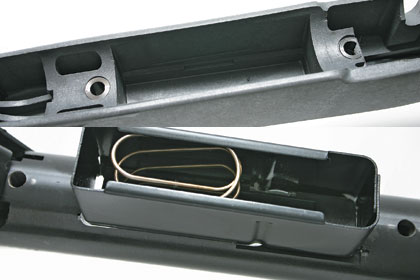 (Top) Dual pillar bedding contributes to the excellent accuracy of the Model 200. (Bottom) The internal box magazine holds four rounds and utilizes a captive coil spring.
(Top) Dual pillar bedding contributes to the excellent accuracy of the Model 200. (Bottom) The internal box magazine holds four rounds and utilizes a captive coil spring.
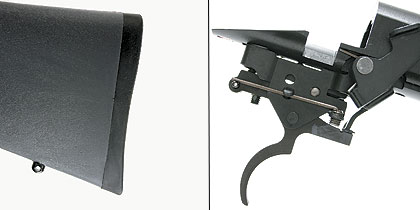 (Left) The gray laminated stock is topped with a solid, rubber recoil pad that is effective at dampening some of the felt recoil. (Right) The most obvious difference between the Stevens Model 200 and the Savage Model 110 is that the Stevens does not have the AccuTrigger of the Savage brand.
(Left) The gray laminated stock is topped with a solid, rubber recoil pad that is effective at dampening some of the felt recoil. (Right) The most obvious difference between the Stevens Model 200 and the Savage Model 110 is that the Stevens does not have the AccuTrigger of the Savage brand.
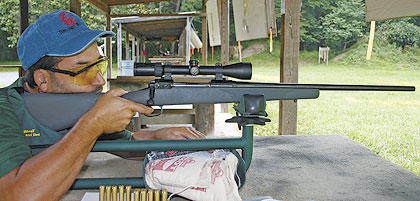 Scott Tested the Stevens Model 200 using a new Simmons ProSport scope and Warne rings and bases. Those choices went together so easily they seemed made for each other.
Scott Tested the Stevens Model 200 using a new Simmons ProSport scope and Warne rings and bases. Those choices went together so easily they seemed made for each other.
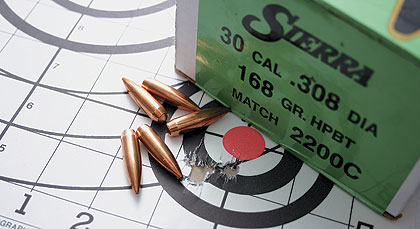 The sample came with a three-shot sub-MOA test target fired using Sierra 168-grain MatchKing bullets. One of the test handloads included the bullet, and it showed the accuracy potential of the Stevens.
The sample came with a three-shot sub-MOA test target fired using Sierra 168-grain MatchKing bullets. One of the test handloads included the bullet, and it showed the accuracy potential of the Stevens.